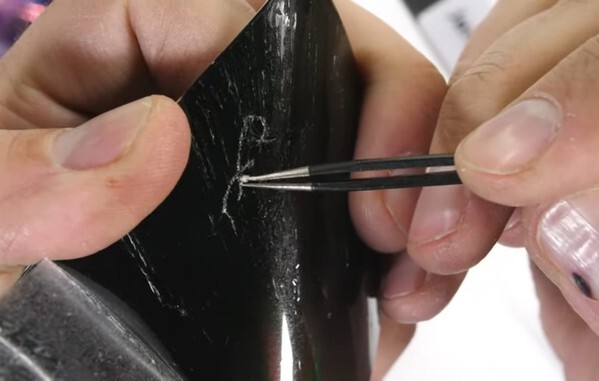hankyoreh
Links to other country sites 다른 나라 사이트 링크
Samsung again faces questions regarding durability of foldable smartphone line

Samsung Electronics is facing questions about the durability of the displays on its second-generation foldable smartphone, called the Galaxy Z Flip. While it’s been confirmed that the display does in fact use ultra-thin glass (UTG), a first for a foldable phone, it’s still susceptible to scratches and external shocks. Analysts also warn of a contraction in the UTG market, which had pinned its hopes on the material’s adoption for foldable phones.
In a Feb. 18 video on his channel JerryRigEverything, YouTuber and IT expert Zack Nelson deconstructed the Galaxy Z Flip, showing that its display is made of UTG. Using a hardness test ranging from 1 to 10 in a prior video, Nelson found that the phone’s display started to scratch at level 2, raising suspicions that the display wasn’t actually made of glass. But in his latest video, Nelson found shining fragments of glass after removing the polyester film attached to the display. Based on how the scratches sound and look, Nelson concluded that it’s definitely glass.
Another video on the Galaxy Z Flip was posted on the YouTube channel PBKreviews, which concluded that the display gets its flexibility from a mixture of glass and plastic.
But once the film was removed, the glass could be scratched with tweezers, which also knocked off some glass fragments. That contradicts the claim by Samsung Electronics that the scratches on the display were actually on the protective film covering the glass. Some people who’d bought the Galaxy Z Flip left reviews on Twitter and a Samsung Electronics community board claiming that the display had cracked after being folded one time, straight out of the package, and that lines had appeared on the display after just a few days of use.

Ultra-thin glass (UTG) has been seen as a next-generation material that could compensate for the shortcomings of colorless and transparent polyimide (CPI) films, which are vulnerable to scratches and creases. Market research firm IHS Markit and NH Investment and Securities predicted that UTG utilization, which stood at 17% in 2020, would increase to 30% in 2023 and 43% in 2025. Corning, in the US, and Asahi Glass, in Japan, both suppliers of precision glass, have launched their own UTG development initiatives, while South Korean reinforced glass producers UTI and JMBC have started manufacturing UTG. The UTG used in the Galaxy Z Flip was made by Dowoo Insys, a South Korean company that developed relevant technology in 2014, using a supply of glass from German company Schott.
But doubts about the UTG’s durability might spell trouble for the market. The UTG used in the Galaxy Z Flip measures 30 microns across, about the width of a strand of human hair. Since competitors Corning and Asahi Glass are also producing UTG with a diameter of less than 100 microns, they also face the same questions about durability.
“The displays being used today are so thin that they run the risk of being scratched or torn by metal. The next-best option for the moment is to use coating materials to reinforce their hardness and flexibility,” said Chung Yong-cheol, an analyst at the Korea Institute of Industrial Technology who developed a nanomaterial for use as a coating film for foldable phones.
“Rollable [display] technology requires a high curvature that makes it impractical for smartphones at the current time, and transparent film is easy to scratch. Ultra-thin glass is vulnerable to external shocks. Compensating for all those issues will probably require considerable research into materials and device design,” said Kim Jae-hun, a professor of electronic engineering at Hanyang University.
By Shin Da-eun, staff reporter
Please direct comments or questions to [english@hani.co.kr]

Editorial・opinion
![[Column] When ‘fairness’ means hate and violence [Column] When ‘fairness’ means hate and violence](https://flexible.img.hani.co.kr/flexible/normal/500/300/imgdb/original/2024/0516/7417158465908824.jpg) [Column] When ‘fairness’ means hate and violence
[Column] When ‘fairness’ means hate and violence![[Editorial] Yoon must stop abusing authority to shield himself from investigation [Editorial] Yoon must stop abusing authority to shield himself from investigation](https://flexible.img.hani.co.kr/flexible/normal/500/300/imgdb/original/2024/0516/4417158464854198.jpg) [Editorial] Yoon must stop abusing authority to shield himself from investigation
[Editorial] Yoon must stop abusing authority to shield himself from investigation- [Column] US troop withdrawal from Korea could be the Acheson Line all over
- [Column] How to win back readers who’ve turned to YouTube for news
- [Column] Welcome to the president’s pity party
- [Editorial] Korea must respond firmly to Japan’s attempt to usurp Line
- [Editorial] Transfers of prosecutors investigating Korea’s first lady send chilling message
- [Column] Will Seoul’s ties with Moscow really recover on their own?
- [Column] Samsung’s ‘lost decade’ and Lee Jae-yong’s mismatched chopsticks
- [Correspondent’s column] The real reason the US is worried about Chinese ‘overcapacity’
Most viewed articles
- 1China calls US tariffs ‘madness,’ warns of full-on trade conflict
- 2[Column] US troop withdrawal from Korea could be the Acheson Line all over
- 3[Editorial] Yoon must stop abusing authority to shield himself from investigation
- 4[Column] When ‘fairness’ means hate and violence
- 5[Column] How to win back readers who’ve turned to YouTube for news
- 6US has always pulled troops from Korea unilaterally — is Yoon prepared for it to happen again?
- 7[Book review] Who said Asians can’t make some good trouble?
- 8Naver’s union calls for action from government over possible Japanese buyout of Line
- 9Could Korea’s Naver lose control of Line to Japan?
- 10[Editorial] Korea must respond firmly to Japan’s attempt to usurp Line